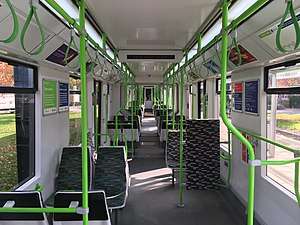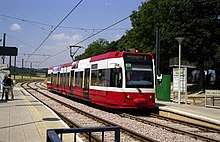Bombardier CR4000
The Bombardier CR4000 is a 76% low floor model of the Flexity Swift series of tram built by Bombardier Transportation and currently in use on Tramlink. They are based on and very similar in appearance to the K4000 built for use on the low-platform routes of the Cologne Stadtbahn network. Built between 1998 and 2000, the trams entered service in the spring of 2000.[1]
| Bombardier CR4000 | |
|---|---|
-_geograph.org.uk_-_1624272.jpg) A CR4000 in current livery | |
 The interior of a refurbished CR4000 | |
| In service | 10 May 2000 – present |
| Manufacturer | Bombardier Transportation |
| Built at | Vienna, Austria |
| Family name | Flexity Swift |
| Constructed | 1998–2000 |
| Refurbished | 2008–2009, 2015 |
| Number built | 24 |
| Number in service | 23 |
| Fleet numbers | 2530–2553 |
| Capacity | 70 seated, 138 standing per tram |
| Operator(s) | Tramlink |
| Depot(s) | Therapia Lane |
| Specifications | |
| Car body construction | Aluminium |
| Train length | 30.10 m (98 ft 9 in) |
| Width | 2.65 m (8 ft 8 in) |
| Height | 3.67 m (12 ft 0 in) |
| Floor height | 350 mm (13.8 in) – 400 mm (15.7 in) |
| Platform height | 350 mm (13.8 in) |
| Entry | 350 mm (13.8 in) |
| Doors | 8 'plug doors' per set |
| Articulated sections | 1 |
| Maximum speed | 50 mph (80 km/h) |
| Weight | 36.3 tonnes (35.7 long tons; 40.0 short tons) per tram |
| Traction system | GTO-VVVF (Kiepe Elektrik) |
| Traction motors | 4x 120 kW (161 hp) Alstom three-phase AC traction motors |
| Acceleration | 1.3 m/s2 (4.3 ft/s2) (2.9 mph per second; 4.7 km/h per second) |
| Electric system(s) | 750 V DC Overhead |
| Current collection method | Pantograph |
| Track gauge | 1,435 mm (4 ft 8 1⁄2 in) standard gauge |
History

24 trams were ordered from Bombardier Transportation and built at their factory in Vienna, Austria between 1998 and 2000. The first tram, 2530, was delivered to Therapia Lane depot on 13 September 1998, with testing beginning soon afterwards. Although service was due to begin in November 1999, delays in the construction of the line meant that the first tram entered passenger service on 10 May 2000.[2][3]
The trams are numbered 2530 through to 2553, following on from the highest numbered tram in the original London Transport numbering system, 2529, which was scrapped in 1952.
Overview
The trams are six-axle single-articulated double-ended cars, with four doors on each side. The low floor section stretches between both the outer doors through the articulation (which rests on an unpowered bogie). Between the outer door and each car end is a higher-floor section, accessed up a step and situated over the car's two power bogies. The low-floor section is 40 cm (16 in) above rail-level, sloping down to 35 cm (14 in) in the doorways, a height that matches the platforms at tram stops, and each car has two wheelchair positions.
The trams are 30.1 m (99 ft) long and 2.65 m (8 ft 8 in) wide, with 70 seats and a total capacity of just over 200 passengers. They operate from an overhead power supply at 750 V DC, and have a maximum speed of 80 km/h (50 mph).
Each tram has an integral traction braking controller with deadman's handle. While stationary, the tram is immobilized until the driver's hand is on the controller: if the driver's hand is removed from the controller while moving, an alarm sounds immediately and the driver's hand must return to the controller to disarm it. If a three-second countdown passes and it is not disarmed, the track brakes are applied.
Upgrades and refurbishment
The trams have undergone a series of upgrades since their introduction. In 2006, the bus-like destination blinds were replaced with LED destination blinds, and the on-board announcements were also updated, featuring the voice of BBC News presenter and tram-enthusiast Nicholas Owen.[4][5]
All 24 trams were refurbished between 2008 and 2009, which involved a deep clean of the interior, installation of new seat moquette and a new lime green, blue and white external livery.[6]
The trams underwent a second refurbishment from 2015-2016. This included a full interior repaint, including the repainting of all handrails, new flooring, new seat moquette, new safety signage and the removal of the stop request buttons. Externally, new LED headlights were fitted. 2553 was the first unit to be completed, having been out of service since 2014 following a serious road traffic accident. Following repairs and refurbishment, it re-entered service in May 2015.[7][8]
Naming
2535 was officially named Stephen Parascandolo 1980 - 2007 in a special ceremony at Beckenham Junction on 20 October 2007, in honour of Stephen Parascandolo, a well known local tram enthusiast and webmaster of the "Unofficial Croydon Tramlink website" who died at the age of 26 in a car accident in Hitchin, Hertfordshire. The ceremony was attended by his parents, fellow enthusiasts and officials from Tramlink.[9]
Accidents and incidents
On 9 November 2016, unit 2551 derailed and overturned on a sharp bend approaching Sandilands Junction, before Sandilands tram stop. There were seven fatalities, with 58 other people injured, sixteen of them sustaining serious injuries. Although the speed limit approaching the junction was 20 km/h (12 mph), the tram had been travelling at an estimated speed of 73 kilometres per hour (46 mph).[10]
The Rail Accident Investigation Branch (RAIB) are investigating the type of glass installed in the CR4000 vehicles. During the derailment, the right hand side of the tram was heavily damaged, breaking or dislodging several bodyside and door windows, and causing multiple people to be ejected or partially ejected from the tram.[10] Of the seven fatalities, six were ejected through the windows. The Office of Rail Regulation (ORR) declined to comment on whether the derailed tram was fitted with laminated safety glass, claiming that it was unable to do so because of the RAIB's investigation.[11] Bombardier did not respond to requests for information on the type of glass that could have been the cause of fatalities in this derailment.[11]
As of July 2019, 2551 has not yet returned to service.[12]
Diagram
References
- https://webcache.googleusercontent.com/search?q=cache:729oYMyq_8UJ:https://www.bombardier.com/en/transportation/projects/project.flexity-uk.html%3Ff-region%3Dmiddle-east-and-africa+&cd=1&hl=en&ct=clnk&gl=uk
- "Delivery". Retrieved 12 January 2019.
- http://www.croydon-tramlink.co.uk/info/history.shtml
- http://www.croydon-tramlink.co.uk/news/index.php?offset=140
- https://www.yourlocalguardian.co.uk/news/1407400.Tramlink_celebrates_its_seventh_birthday/
- Millard, Neil (3 April 2009). "End of an era as Croydon's last red tram turns green". Croydon Advertiser. Archived from the original on 7 October 2010. Retrieved 27 April 2010.
- http://www.greaterlondonphotos.co.uk/bombardier-trams.html#
- http://www.britishtramsonline.co.uk/news/?p=11373
- https://www.thetrams.co.uk/croydon/sjp/
- "Fatal accident involving the derailment of a tram at Sandilands Junction, Croydon, 9 November 2016" (PDF). Rail Accident Investigation Branch. 20 February 2017. Retrieved 10 April 2017.
- "Did type of glass in crashed tram's windows contribute to deaths?". Croydon Advertiser. 24 November 2016. Retrieved 15 December 2016.
- "Croydon Tram 2551". Transport for London via WhatDoTheyKnow. 24 June 2019. Retrieved 7 May 2020.
External links
| Wikimedia Commons has media related to Bombardier CR4000. |
- "London Trams". Transport for London. Archived from the original on 21 March 2014. Retrieved 11 July 2008.
- Parascandolo, Stephen. "Croydon Tramlink - The Unofficial Website". Retrieved 11 July 2008.
- "London Croydon Tramlink Underground Real Distance Map". City Rail Transit. Retrieved 11 July 2008.
- Bombardier. "Bombardier Flexity Swift: London-Croydon, United Kingdom" (PDF). Archived from the original (PDF) on 6 March 2012.